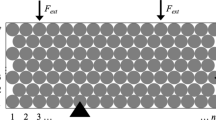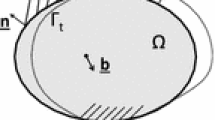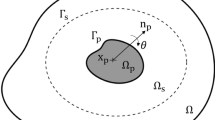Abstract
The strain formulation in elasticity and the compatibility condition in structural mechanics have neither been understood nor have they been utilized. This shortcoming prevented the formulation of a direct method to calculate stress and strain, which are currently obtained indirectly by differentiating the displacement. We have researched and understood the compatibility condition for linear problems in elasticity and in finite element structural analysis. This has lead to the completion of the “method of force” with stress (or stress resultant) as the primary unknown. The method in elasticity is referred to as the completed Beltrami-Michell formulation (CBMF), and it is the integrated force method (IFM) in the finite element analysis. The dual integrated force method (IFMD) with displacement as the primary unknown had been formulated. Both the IFM and IFMD produce identical responses. The IFMD can utilize the equation solver of the traditional stiffness method. The variational derivation of the CBMF produced the existing sets of elasticity equations along with the new boundary compatibility conditions, which were missed since the time of Saint-Venant, who formulated the field equations about 1860. The CBMF, which can be used to solve stress, displacement, and mixed boundary value problems, has eliminated the restriction of the classical method that was applicable only to stress boundary value problem. The IFM in structures produced high-fidelity response even with a modest finite element model. Because structural design is stress driven, the IFM has influenced it considerably. A fully utilized design method for strength and stiffness limitation was developed via the IFM analysis tool. The method has identified the singularity condition in structural optimization and furnished a strategy that alleviated the limitation and reduced substantially the computation time to reach the optimum solution. The CBMF and IFM tensorial approaches are robust formulations because both methods simultaneously emphasize the equilibrium equation and the compatibility condition. The vectorial displacement method emphasized the equilibrium, while the compatibility condition became the basis of the scalar stress-function approach. The tensorial approach can be transformed to obtain the vector and the scalar methods, but the reverse course cannot be followed. The tensorial approach outperformed other methods as expected. This paper introduces the new concepts in elasticity, in finite element analysis, and in design optimization with numerical illustrations.
Similar content being viewed by others
References
Timoshenko SP (1983) History of strength of materials. Dover, New York
Ferrers NM (ed) (1871) Mathematical papers of the late George Green. Macmillan, London
Patnaik SN (1986) The variational energy formulation for the integrated force method. AIAA J 24(1):129–137
Przemieniecki JS (1968) Theory of matrix structural analysis. McGraw-Hill, New York
Patnaik SN, Hopkins DA (2004) Strength of materials, a unified theory for the 21st century. Elsevier, Amsterdam
Patnaik SN, Hopkins DA (2005) Completed Beltrami Michell formulation in polar coordinates. NASA/TM-2005-213634
Sokolnikoff IS (1956) Mathematical theory of elasticity, 2nd edn. McGraw-Hill, New York
Patnaik SN, et al. (1996) Completed Beltrami-Michell formulation for analyzing mixed boundary value problems in elasticity. AIAA J 34(1):143–148
Patnaik SN, Berke L, Gallagher RH (1991) Integrated force method versus displacement method for finite-element analysis. Comput Struct 38(4):377–407
Patnaik SN (1986) The integrated force method versus the standard force method. Comput Struct 22(2):151–163
Patnaik SN et al. (1992) Improved accuracy for finite-element structural-analysis via an integrated force method. Comput Struct 45(3):521–542
Dayaratnam P, Patnaik S (1969) Feasibility of full stress design. AIAA J 7:773–774
Patnaik S, Dayaratnam P (1970) Behaviour and design of pin connected structures. Int J Numer Methods Eng 2(4):579–595
Love AEH (1927) A treatise on the mathematical theory of elasticity. University Press, Cambridge
Ritz W (1909) Uber eine neue Methode zur Losung gewisser Variationsprobleme der mathematischen Physik. J Reine Angew Math 135:1–61
Timoshenko SP (1940) Theory of plates and shells. McGraw-Hill, New York
Park KC, Felippa CA (2000) A variational principle for the formulation of partitioned structural systems. Int J Numer Methods Eng 47:395–418
Denke PH (1959). A general digital computer analysis of statically indeterminate structures. NASA TN D-1666
Patnaik SN, Yadagiri S (1982) Frequency-analysis of structures by integrated force. Method J Sound Vib 83(1):93–109
Patnaik SN, Berke L, Gallagher RH (1991) Compatibility conditions of structural mechanics for finite-element analysis. AIAA J 29(5):820–829
Hopkins D, et al. (2002) Fidelity of the integrated force method solution. Int J Numer Methods Eng 55(11):1367–1371
Patnaik SN, Coroneos RM, Hopkins DA (1997) Dynamic animation of stress modes via the integrated force method of structural analysis. Int J Numer Methods Eng 40(12):2151–2169
Storaasli OO, Baddourah M, Nguyen D (1995) GPS: general purpose solver. NASA Langley Software
HARWELL subroutine library specifications (1990) Harwell Laboratory, Oxfordshire, OX11 ORA, England
Batoz J-L, Dhatt G (1990) Modélisation des structures par éléments finis. Solides élastiques, vol 1. Hermes, Paris
Cilley FH (1900) The exact design of statically indeterminate frameworks. An exposition of its possibility, but futility. Trans Am Soc Civil Eng 42:353–407
Reinschmidt KF, Cornell CA, Brotchie JF (1966) Iterative design and structural optimization, American society of civil engineering. J Struct Div 92(281):281–318
Gallagher RH (1973) Fully stressed design. In: Gallagher RH, Zienkiewicz OC (eds) Optimum structural design. Wiley, London, pp 19–32
Patnaik SN (1986) Behavior of trusses with stress and displacement constraints. Int J Comput Struct 22:619–623
Patnaik SN, Guptill JD, Berke L (1993) Singularity in structural optimization. Int J Numer Methods Eng 36:931–944
Patnaik SN, Gendy AS, Hopkins DA (1998) Modified fully utilized method (MFUD) for stress and displacement constraints. Int J Numer Methods Eng 41:1171–1194
Patnaik SN, Pai SS, Hopkins DA (2006). Precision of sensitivity in the design optimization of indeterminate structures. NASA/TP-2006-213818
Patnaik SN, Gallagher RH (1988) Gradients of behavior constraints and reanalysis via the integrated force method. Int J Numer Methods Eng 23:2205–2212
Patnaik SN, Hopkins DA (2001). Stress formulation in three-dimensional elasticity. NASA/TP-2001-210515
Washizu K (1958) A note on the conditions of compatibility. J Math Phys 36:306–312
Author information
Authors and Affiliations
Corresponding author
Rights and permissions
About this article
Cite this article
Patnaik, S.N., Pai, S.S. & Hopkins, D.A. Compatibility Condition in Theory of Solid Mechanics (Elasticity, Structures, and Design Optimization). Arch Computat Methods Eng 14, 431–457 (2007). https://doi.org/10.1007/s11831-007-9011-9
Accepted:
Published:
Issue Date:
DOI: https://doi.org/10.1007/s11831-007-9011-9




